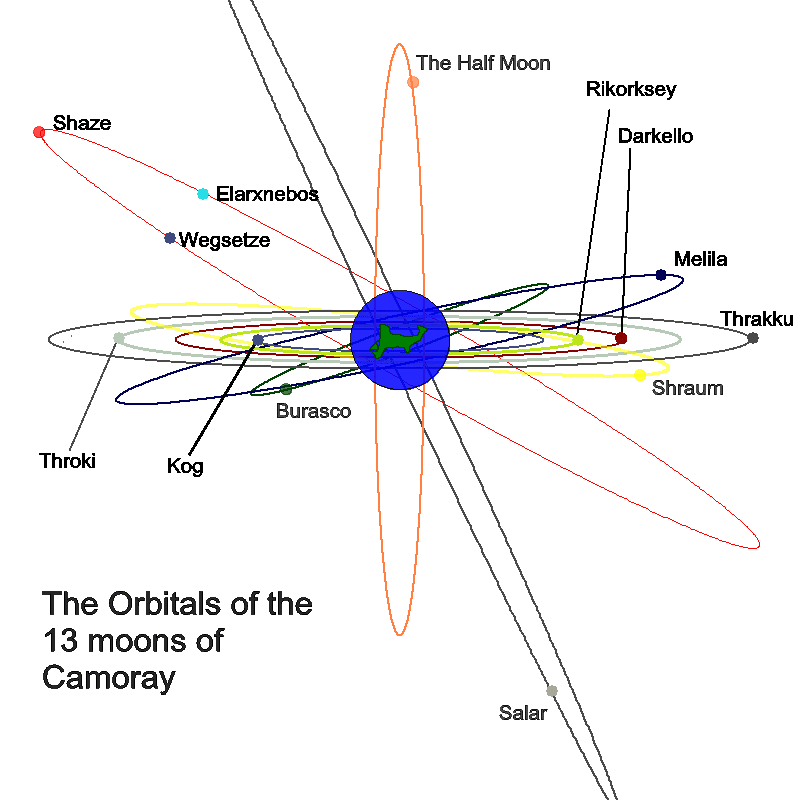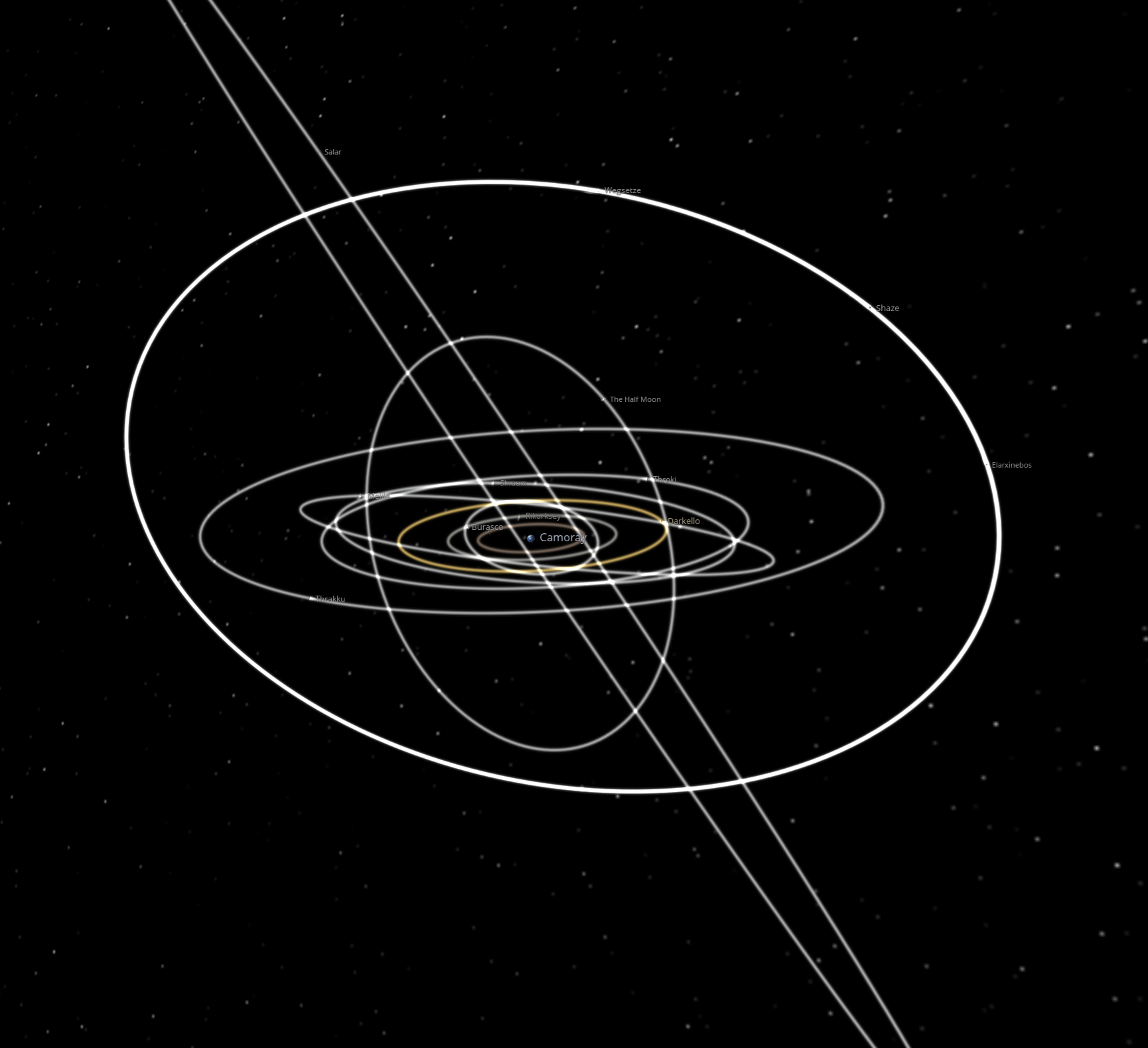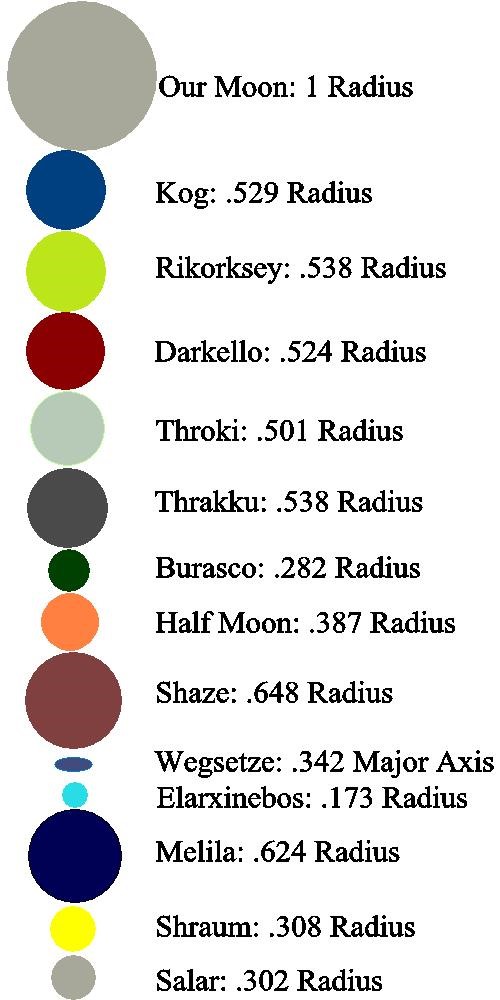The Solar System - The 13 Moons of Camoray
Camoray has thirteen moons. There is speculation about whether Pyrideon had thirteen moons before Coalescence with most scholars believing only nine such moons existed. If true, that means the other four moons were from other worlds destroyed in Coalescence.
Each of the thirteen moons was named after one of the now deceased Gods of War. (The Gods of War only came by that name after they were deposed of by the Gods of Peace – until then they were just the Thirteen Gods.)
The orbitals of the Thirteen moons can be seen in these two pictures.
The first picture gives a fairly accurate position with regards to Camoray while the second picture displays better the distance and sizes of each moon compared to Camoray.
The thirteen moons are as follows.
The first five moons listed are all on the same orbital plane as Camoray, share an orbital resonance, and orbit in lockstep with one another. Each of these 5 moons takes twice as long as the next moon closer to Camoray to orbit.
- Kog: The closest moon, though small, appears at about 85% the size of the Moon due to its proximity and circles Camoray about once every 3.1 days. Sometimes referred to as the ‘Blue Seeker’ or ‘Beautiful Slayer’ due to its color and speed. The moon is dark blue with red streaks. The red moves and changes indicating the presence of an atmosphere. The atmosphere actually increases the albedo (reflectiveness) of the moon so it appears rather bright in the sky.
- Rikorskey: The third closest moon appears about 53% the size of the Moon. Rikorskey circles Camoray once every 6.2 days. It is a yellowish green moon. Rikorskey’s alternate names include ‘Black Justice’ (a reference to its namesake, not to the moon’s color) and ‘Vengeance Star’.
- Darkello: The fourth closest moon which appears about 18% the size of the Moon. Darkello circles Camoray once every 12.4 days. The moon is a solid dark rust red in color and is sometimes referred to as ‘Night’s Fire.’
- Throki: Throki appears about 10% the size of the Moon circles Camoray once every 24.8 days. This moon is grayish white with a slight tint of green. The green does moves around the planet like wispy clouds indicating the presence of an atmosphere. This moon is also referred to as the ‘Law Giver.’ The presence of an atmosphere greatly enhances its overall visibility from Camoray.
- Thrakku: This is the final moon to share any orbital resonance with other moons and appears less than 3% the size of the Moon. Thrakku circles Camoray once every 49.6 days. The moon is obsidian black and is usually next to impossible to see unless it passes in front of another object. When full, it can be made out barely with the naked eye on the background of a clear sky. It is also known as the ‘Dark Orb’ or ‘The Dispiser’ due to its coloring. This moon is often associated with Ramian Fax, the god of darkness. Certain sects of Ramian Fax share an osiron which allows them to see the magnetic and heat glow of the moon, supposedly casting the moon in a hellish fire of green light with occasional lapses of red.
- Burasco: Burasco circles Camoray in a slightly elliptical orbit with a period of 4.37 days and appears about 70% the size of the Moon due to a much closer proximity. Due to a 20 degree tilt in its orbit which is locked with the Heliyons, this dark green moon often seems to follow the suns at an angle after they set or follows them up once they rise. Due to this observation, it has been dubbed the ‘Sun Chaser.’
- The Half-Moon: It is one of the larger moons and appears about 41% the size of the Moon. Its orbital period is roughly 25.25 days and its coloring is a solid pale orange. What makes the Half-Moon unique is that its orbit around Camoray is locked in such a way that the orbit is always a true 90 degrees to the orbital plane while the orbit itself is always perpendicular to the suns. Essentially the orbit angle in relation to the Heliyon slowly revolves around Camoray once a year. The moon is always half full in the sky. (The moon itself does revolve about once every 26 days, it’s only a few thousand years from being tidally locked with Camoray.)
- Shaze: It is the largest of the moons and while actually bigger than our moon, due to its distance only appears about 26% the size of the Moon. Its coloring is a dark purplish red. As such, it is also referred to as ‘Blood Binge.’
- Wegsetze: Wegsetze trails Shaze in the same orbit by 12 days and occupies the L4 Lagrange point of Shaze and Camoray. The moon is bluish grey and rather small. Combined with its distance, it appears less than 1% the size of our moon. Due to its star-like appearance from a distance, it creates the effect that Shaze is being chased by a star. It is also the only non-spherical moon existing in flattened oval shape. Its name has been coined ‘The Humiliator’ after the dark god it represents.
- Elarxinebos: This moon, in turn, precedes Shaze by 12 days and occupies the L5 Lagrange point. Also a small moon, it appears less than 1% the size of the Moon which means it appears like a large star. This moon appears to be mostly solid ice and can appear rather brightly despite its minuscule size. Like all the other moons, it has an alternate name, though no one uses it. That name is ‘Mind Slasher.’
- Melila: The the second largest moon appears about 27% the size of the Moon. It orbits Camoray at a 12-degree inclination with a period of 29.1 days. Its midnight blue coloring has earned it the nick name of ‘Dark Mother.’
- Shraum: Shraum appears about 10% the size of the Moon and orbits Camoray with a minimal 6-degree inclination and a period of 22.5 days. The moon is a light sulphurish yellow. This moon is called the ‘Nullifier’ due to its namesake.
- Salar: The final moon orbits once every 138.4 days. Due to its highly elliptical orbit sitting at 65 degrees above the orbital plane, it actually approaches closer than Kog during its perigee. The moon is a solid grayish color (very similar to our Moon). Because it travels so close several times a year before shrinking where it almost can’t be seen unaided, it has picked up the common name of ‘Wandering Child.’ At its closest approach, it appears nearly 108% the size of our moon, while at its farthest it is a bare .1% the size of the Moon.






Comments